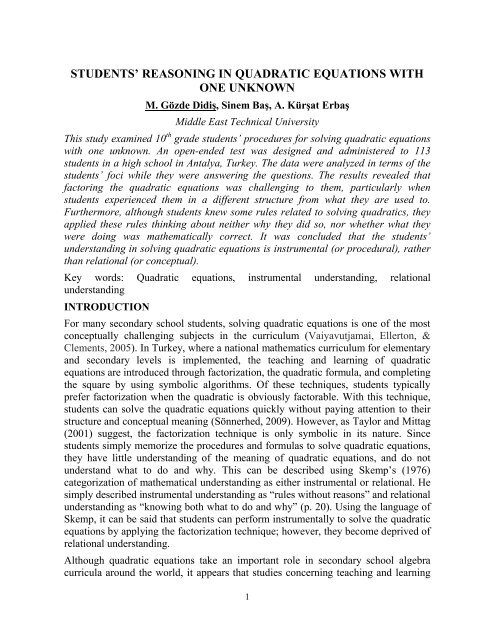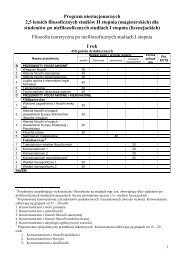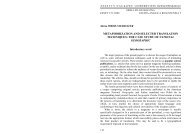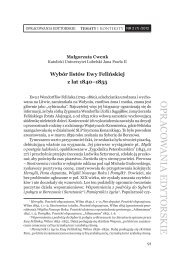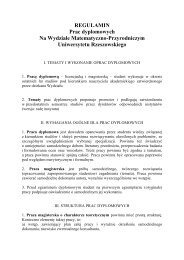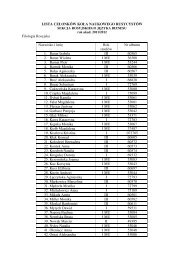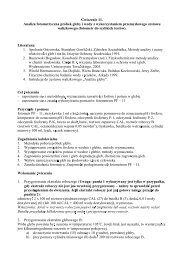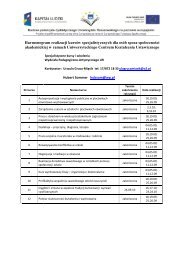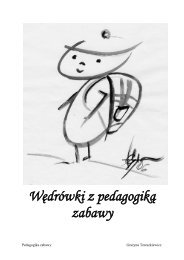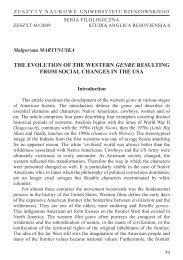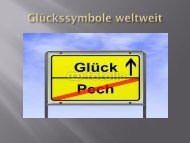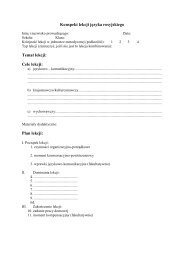reasoning in quadratic equations with one unknown - Cerme 7
reasoning in quadratic equations with one unknown - Cerme 7
reasoning in quadratic equations with one unknown - Cerme 7
You also want an ePaper? Increase the reach of your titles
YUMPU automatically turns print PDFs into web optimized ePapers that Google loves.
STUDENTS’ REASONING IN QUADRATIC EQUATIONS WITHONE UNKNOWNM. Gözde Didiş, S<strong>in</strong>em Baş, A. Kürşat ErbaşMiddle East Technical UniversityThis study exam<strong>in</strong>ed 10 th grade students’ procedures for solv<strong>in</strong>g <strong>quadratic</strong> <strong>equations</strong><strong>with</strong> <strong>one</strong> <strong>unknown</strong>. An open-ended test was designed and adm<strong>in</strong>istered to 113students <strong>in</strong> a high school <strong>in</strong> Antalya, Turkey. The data were analyzed <strong>in</strong> terms of thestudents’ foci while they were answer<strong>in</strong>g the questions. The results revealed thatfactor<strong>in</strong>g the <strong>quadratic</strong> <strong>equations</strong> was challeng<strong>in</strong>g to them, particularly whenstudents experienced them <strong>in</strong> a different structure from what they are used to.Furthermore, although students knew some rules related to solv<strong>in</strong>g <strong>quadratic</strong>s, theyapplied these rules th<strong>in</strong>k<strong>in</strong>g about neither why they did so, nor whether what theywere do<strong>in</strong>g was mathematically correct. It was concluded that the students’understand<strong>in</strong>g <strong>in</strong> solv<strong>in</strong>g <strong>quadratic</strong> <strong>equations</strong> is <strong>in</strong>strumental (or procedural), ratherthan relational (or conceptual).Key words: Quadratic <strong>equations</strong>, <strong>in</strong>strumental understand<strong>in</strong>g, relationalunderstand<strong>in</strong>gINTRODUCTIONFor many secondary school students, solv<strong>in</strong>g <strong>quadratic</strong> <strong>equations</strong> is <strong>one</strong> of the mostconceptually challeng<strong>in</strong>g subjects <strong>in</strong> the curriculum (Vaiyavutjamai, Ellerton, &Clements, 2005). In Turkey, where a national mathematics curriculum for elementaryand secondary levels is implemented, the teach<strong>in</strong>g and learn<strong>in</strong>g of <strong>quadratic</strong><strong>equations</strong> are <strong>in</strong>troduced through factorization, the <strong>quadratic</strong> formula, and complet<strong>in</strong>gthe square by us<strong>in</strong>g symbolic algorithms. Of these techniques, students typicallyprefer factorization when the <strong>quadratic</strong> is obviously factorable. With this technique,students can solve the <strong>quadratic</strong> <strong>equations</strong> quickly <strong>with</strong>out pay<strong>in</strong>g attention to theirstructure and conceptual mean<strong>in</strong>g (Sönnerhed, 2009). However, as Taylor and Mittag(2001) suggest, the factorization technique is only symbolic <strong>in</strong> its nature. S<strong>in</strong>cestudents simply memorize the procedures and formulas to solve <strong>quadratic</strong> <strong>equations</strong>,they have little understand<strong>in</strong>g of the mean<strong>in</strong>g of <strong>quadratic</strong> <strong>equations</strong>, and do notunderstand what to do and why. This can be described us<strong>in</strong>g Skemp’s (1976)categorization of mathematical understand<strong>in</strong>g as either <strong>in</strong>strumental or relational. Hesimply described <strong>in</strong>strumental understand<strong>in</strong>g as “rules <strong>with</strong>out reasons” and relationalunderstand<strong>in</strong>g as “know<strong>in</strong>g both what to do and why” (p. 20). Us<strong>in</strong>g the language ofSkemp, it can be said that students can perform <strong>in</strong>strumentally to solve the <strong>quadratic</strong><strong>equations</strong> by apply<strong>in</strong>g the factorization technique; however, they become deprived ofrelational understand<strong>in</strong>g.Although <strong>quadratic</strong> <strong>equations</strong> take an important role <strong>in</strong> secondary school algebracurricula around the world, it appears that studies concern<strong>in</strong>g teach<strong>in</strong>g and learn<strong>in</strong>g1
<strong>quadratic</strong> <strong>equations</strong> are quite scarce <strong>in</strong> algebra education research (Kieran, 2007;Vaiyavutjamai & Clements, 2006). Therefore, this study was designed to widen theresearch consider<strong>in</strong>g students’ <strong>reason<strong>in</strong>g</strong> when engag<strong>in</strong>g <strong>in</strong> different types of<strong>quadratic</strong> <strong>equations</strong> <strong>in</strong> <strong>one</strong> <strong>unknown</strong>. In particular, this study <strong>in</strong>vestigated students’processes for solv<strong>in</strong>g <strong>quadratic</strong> <strong>equations</strong> <strong>with</strong> <strong>one</strong> <strong>unknown</strong> by us<strong>in</strong>g thefactorization technique.The f<strong>in</strong>d<strong>in</strong>gs of this study may provide teachers <strong>with</strong> <strong>in</strong>sight <strong>in</strong>to the <strong>reason<strong>in</strong>g</strong> thatleads to the common mistakes that students make while solv<strong>in</strong>g <strong>quadratic</strong> <strong>equations</strong>,and hence guide them <strong>in</strong> creat<strong>in</strong>g a more efficient pedagogical design for teach<strong>in</strong>ghow to solve <strong>quadratic</strong>s.Challenges faced by Students <strong>in</strong> Solv<strong>in</strong>g Quadratic EquationsAccord<strong>in</strong>g to Kotsopoulos (2007), for many secondary school students, solv<strong>in</strong>g<strong>quadratic</strong> <strong>equations</strong> is <strong>one</strong> of the most conceptually challeng<strong>in</strong>g aspects <strong>in</strong> the highschool curriculum. She <strong>in</strong>dicated that many students encounter difficulties recall<strong>in</strong>gma<strong>in</strong> multiplication facts, which directly <strong>in</strong>fluences their ability to engage <strong>in</strong><strong>quadratic</strong>s. And, s<strong>in</strong>ce the factorization technique of solv<strong>in</strong>g <strong>quadratic</strong> <strong>equations</strong>requires students to be able to rapidly f<strong>in</strong>d factors, factor<strong>in</strong>g simple <strong>quadratic</strong>s (i.e.,x 2 +bx+c=0 where b, c R) become a quite challenge, while non-simple <strong>quadratic</strong>s(i.e., ax 2 +bx+c=0 a, b, c R and a≠1) become nearly impossible. Moreover,students encounter crucial difficulties <strong>in</strong> factor<strong>in</strong>g <strong>quadratic</strong> <strong>equations</strong> if they arepresented <strong>in</strong> non-standard forms. For example, factor<strong>in</strong>g x 2 +3x+1=x+4 ischalleng<strong>in</strong>g for students, s<strong>in</strong>ce the equation is not presented <strong>in</strong> standard form(Kotsopoulos, 2007). Similarly, Bossè and Nandakumar (2005) stated that thefactor<strong>in</strong>g techniques for solv<strong>in</strong>g <strong>quadratic</strong> <strong>equations</strong> are problematic for students.They <strong>in</strong>dicated that students can f<strong>in</strong>d factor<strong>in</strong>g the <strong>quadratic</strong>s considerably morecomplicated when the lead<strong>in</strong>g coefficient or constant <strong>in</strong> the <strong>quadratic</strong> has many pairsof possible factors.Skemp’s (1976) description of <strong>in</strong>strumental and relational understand<strong>in</strong>g can be usedas a framework to discuss the difficulties students have <strong>with</strong> factor<strong>in</strong>g <strong>quadratic</strong><strong>equations</strong>. While an <strong>in</strong>strumental understand<strong>in</strong>g of factoriz<strong>in</strong>g <strong>quadratic</strong> <strong>equations</strong><strong>with</strong> <strong>one</strong> <strong>unknown</strong> requires memoriz<strong>in</strong>g rules for <strong>equations</strong> presented <strong>in</strong> particularstructures, relational understand<strong>in</strong>g enables students to apply these rules to differentstructures easily (Reason, 2003). That is, when students have relationalunderstand<strong>in</strong>g, they can transfer knowledge of both what rules (and formulas) workedand why they worked from <strong>one</strong> situation to another (Skemp, 2002).Lima (2008) found that students may perceive <strong>quadratic</strong> <strong>equations</strong> just like they docalculations. S<strong>in</strong>ce they focus mostly on the symbols used to perform operations, theymay not be aware of the concepts that are <strong>in</strong>volved. Vaiyavutjamai and Clements(2006) expla<strong>in</strong> that students’ difficulties <strong>with</strong> <strong>quadratic</strong> <strong>equations</strong> arise from the lackof both <strong>in</strong>strumental and relational understand<strong>in</strong>g of the associated mathematics.They found several misconceptions regard<strong>in</strong>g variables which were obstacles to2
understand<strong>in</strong>g <strong>quadratic</strong> <strong>equations</strong>. For example, students thought that the two x’s <strong>in</strong>the equation (x-3) ∙(x-5) =0 stood for different variables, even though most of themobta<strong>in</strong>ed the correct solutions x=3 and x=5. Hence, they concluded that students’performance <strong>in</strong> that context reflect rote learn<strong>in</strong>g and a lack of relationalunderstand<strong>in</strong>g.METHODOLOGYParticipants and the InstrumentThe sample of this study consisted of 113 students <strong>in</strong> four 10 th grade classes, and thisstudy was performed <strong>in</strong> a high school <strong>in</strong> Antalya, Turkey dur<strong>in</strong>g the spr<strong>in</strong>g term2009-2010.For the purpose of the study, a questionnaire was formed by the authors s<strong>in</strong>ce no testto specifically explore students’ errors and understand<strong>in</strong>g was available. The testquestions were carefully selected from secondary mathematics textbooks and fromresearch regard<strong>in</strong>g <strong>quadratic</strong> <strong>equations</strong> (e.g., Crouse & Sloyer, 1977). All questionsused <strong>in</strong> this questionnaire were selected to measure the study objective ofdeterm<strong>in</strong><strong>in</strong>g how students “determ<strong>in</strong>e the roots and solution set of [a] <strong>quadratic</strong>equation <strong>in</strong> <strong>one</strong> <strong>unknown</strong>”. Dur<strong>in</strong>g the selection process, two mathematics educatorsand a mathematics teacher were consulted about whether the content of the selectedquestions were consistent <strong>with</strong> the objective of the test. In light of their suggestions,seven open ended question were determ<strong>in</strong>ed. Although the format of the all of thequestions was open-ended, they varied <strong>in</strong> type so as to be consistent <strong>with</strong> theobjective of the study. Questions 1 to 4 were <strong>in</strong> the standard format <strong>in</strong> which studentswere expected to “f<strong>in</strong>d the solution set of the given <strong>quadratic</strong> equation”. Thesequestions were based on procedural skills, and they were mostly used to detectstudents’ procedural abilities <strong>in</strong> solv<strong>in</strong>g <strong>quadratic</strong> <strong>equations</strong> <strong>in</strong> different structures. Onthe other hand, questions 5 to 7 <strong>in</strong>troduced a mathematical scenario that <strong>in</strong>cludedboth a <strong>quadratic</strong> equation and a solution belong<strong>in</strong>g to it. In these type of questions,students were expected to determ<strong>in</strong>e “whether the solutions [belong<strong>in</strong>g to] the<strong>equations</strong> were correct or not, and to make judgment about their decision”.Therefore, <strong>in</strong> addition to procedural skills, these questions were used to detectstudents’ understand<strong>in</strong>g of and <strong>reason<strong>in</strong>g</strong> level when deal<strong>in</strong>g <strong>with</strong> <strong>quadratic</strong><strong>equations</strong>.The mathematics teacher adm<strong>in</strong>istered the questionnaire dur<strong>in</strong>g the regular classperiod and the students were given 30 m<strong>in</strong>utes to complete it.Analysis of DataInitially, the responses given to each question were givens scores of either 1 or 0. Ascore of 1 was given for answers that were mathematically correct <strong>in</strong> terms of bothsolution process and f<strong>in</strong>al answer. A score of 0 was given for answers that were eitheromitted or <strong>in</strong>correct <strong>in</strong> terms of either solution process or f<strong>in</strong>al answer. Then, <strong>in</strong> orderto obta<strong>in</strong> a general view of the students’ performance, the percentage of correct,3
<strong>in</strong>correct and omitted questions were calculated. The aim of this process wasdescriptive analysis. Afterwards, qualitative data analysis was conducted. Thesubjects’ responses were studied <strong>in</strong> order to provide substantial <strong>in</strong>formation abouttheir type of understand<strong>in</strong>g. In this analysis, it was attempted to identify the commonmistakes that students made while solv<strong>in</strong>g the <strong>quadratic</strong> <strong>equations</strong>. Therefore, the<strong>in</strong>correct answers for all questions have been analyzed item by item <strong>with</strong> respect tothe students’ focus when they solved the questions <strong>in</strong> the test situation. In thisprocess, students’ types of mistakes were coded by two researchers of this study whoworked <strong>in</strong>itially separately. Next, the mistakes were both comb<strong>in</strong>ed and renamedbased on their common features, and then they were classified by two researcherstogether. Lastly, these mistakes were <strong>in</strong>terpreted <strong>in</strong> terms of students’ <strong>in</strong>strumentalunderstand<strong>in</strong>g and relational understand<strong>in</strong>g.RESULTThe first item <strong>in</strong> the <strong>in</strong>strument was related to f<strong>in</strong>d<strong>in</strong>g the roots of a <strong>quadratic</strong>equation given <strong>in</strong> standard form (e.g., ax 2 +bx+c=0 where a, b, c R). Almost allstudents correctly solved this equation by factorization. In the follow<strong>in</strong>g questions,<strong>quadratic</strong> <strong>equations</strong> were given <strong>in</strong> different structures (e.g., ax 2 -bx=0, c=0). In thesetypes of questions, just 64% of them solved the equation ax 2 -bx=0, correctly. Whenthe solution processes of students who made mistakes (36%) were analyzed, it wasrecognized that their mistakes were based on two different types.“F<strong>in</strong>d the solution set of the equation 2 − 2 = 0”.Figure 1: An example of students’ first type of mistake“F<strong>in</strong>d the solution set of the equation 2 − 2 = 0”.Figure 2: An example of students’ second type of mistake4
“F<strong>in</strong>d the solution set of the equation “ 2 − = 12”Figure 3: An example of students’ mistake when just the form of equation changed.In the first type of wrong solution (see Figure 1), students carried the term -2x fromleft side to the right, and then simplified the term x <strong>in</strong> both sides of the equation.Consequently, they ignored <strong>one</strong> of the roots of the equation, which is 0. In the secondtype of wrong solution (see Figure 2), students tried to factorize the equation. Here,students perceived the form ax 2 -bx=0 just like ax 2 +bx+c=0 and thought -2x as theconstant term of the <strong>quadratic</strong> <strong>equations</strong>. Even, when just the form of the equationwas changed <strong>in</strong>stead of the structure (e.g., ax 2 +bx=c where a, b, c≠0), 12% of thestudents <strong>in</strong>correctly solved the <strong>quadratic</strong>. Because the constant term was <strong>in</strong> the rightside, they didn’t perceive that the equation was <strong>in</strong> standard form (see Figure 3). Inthis type of solution, they were able to f<strong>in</strong>d only <strong>one</strong> of the roots, 4.StatementsQuestion 5To solve the equation“(x-3)∙(x-2) = 0”for real numbers, Alianswered <strong>in</strong> a s<strong>in</strong>glel<strong>in</strong>e that:“x=3 or x=2”Is this answercorrect? If it is correct,how can you show itcorrectness?Students’ types of responses <strong>with</strong> their <strong>reason<strong>in</strong>g</strong>I. II. III. IV.“The answer isRight”S<strong>in</strong>ce I wrote(x-3)∙(x-2) = 0as x 2 -5x+6=0and then I factorizeto f<strong>in</strong>d roots of it.from (x-3)=0 andfrom (x-2)=0“x=3 and x=2”Table 1: Common examples of students’ types of responses <strong>with</strong> their <strong>reason<strong>in</strong>g</strong> forquestion 5.Although all of the students stated that Ali’s answer was correct by choos<strong>in</strong>g either<strong>one</strong> of the statements I, II, III, and IV, the ways they justified for the correctness ofAli’s solution were different. For <strong>in</strong>stance, <strong>in</strong> statement I, students first transformedthe factorized expression <strong>in</strong>to the standard form, and then factorized the expressionaga<strong>in</strong> <strong>in</strong> the same way and found the roots by rote. In statement II, studentsunconsciously applied the null factor law. In statement III, the way of justification forsolution was based on substitution method. In all of these three statements, they couldnot clearly justify the correctness of the solution. In statement IV, students substitutedx=3 <strong>in</strong>to (x-3) and x=2 <strong>in</strong>to (x-2) simultaneously, and concluded that their solution5“The answeris Right”Because(x-3)=0(x-2)=0x=3x=2“Theanswer isRight”.S<strong>in</strong>ce wesubstitute“3 and 2”<strong>in</strong>to x, theequation isprovided.(explanationmade only<strong>with</strong> words)“The answer isRight”.If the x=2and x=3 aresubstituted <strong>in</strong>tothe equation(3-3)⋅ (2-2)=00.0 = 0
were correct s<strong>in</strong>ce 0∙0=0. Namely, they thought that the two x’s stood for differentnumbers.StatementsQuestion 6A student hands <strong>in</strong> thefollow<strong>in</strong>g work for thefollow<strong>in</strong>g problem.Solve ;x 2 -14x+24=3(x-12)∙(x-2)=3(x-12)∙(x-2)=3∙1x-12=3 x-2=1x=15 x=3Ç.K= {3, 5}Is the student correct?Expla<strong>in</strong> your answer <strong>with</strong>its reasons?“The answeris Wrong”Because,firstly, 3 mustcarry the leftside of theequation andequalize the0. Then, theotheroperationsmust be d<strong>one</strong>.In this way,the equationx 2 -14x+21=0Students’ types of responses <strong>with</strong> their <strong>reason<strong>in</strong>g</strong>I. II. III. IV.“Theanswer isWrong”.Becausewhen wesubstitute 3and 15 forx, theequation isnotprovided.“The answer isRight”S<strong>in</strong>ce the result isequal to 3, weequate 3 rather than0 while factor<strong>in</strong>g it.Therefore, theresult is true.Students aga<strong>in</strong>solve as:“x 2 -14x+24=3”(x-12)∙(x-2)=3(x-12)∙ (x-2)=3∙1x-12=3 x-2=1x=15 x=3(3,1)“The answer isWrong”S<strong>in</strong>ce the<strong>equations</strong> areseparated as(3,1) there is noerror when(x-12)=3however, thereis error when(x-2)=1.It must be(x-2)=3 then,x=5. Therefore,the solution willbe {5, 15}rather than{3, 15}.Table 2: Common examples of students’ types of responses <strong>with</strong> their <strong>reason<strong>in</strong>g</strong> forquestion 6.In statements I and II (see Table 2), students were aware of the error <strong>in</strong> the solution ofthe given question. However, to expla<strong>in</strong> the reasons for the mistake, they presentedprocedural explanations like the responses <strong>in</strong> statements I, II, III for question 5 (seeTable 1). In statement III, students <strong>in</strong>correctly stated that the answer was right.Look<strong>in</strong>g at the statement “s<strong>in</strong>ce the result is equal to 3, we equate to 3 rather than 0while factor<strong>in</strong>g it”, it can be said that they wrongly tried to transfer the null factor lawto this context. That is, they equated the factors of equation x 2 -14x+24 <strong>with</strong> the<strong>in</strong>teger factors of 3. In statement IV, students correctly claimed “the answer of thequestion wrong”; however, their explanations were fully err<strong>one</strong>ous. Similar tostatement III, these students tried to apply the null factor law to the equation.N<strong>one</strong>theless, <strong>in</strong> this case, they only equated the factors to 3 rather than to the factorsof 3. In both statements III and IV, students did not check whether the roots theyfound were appropriate or not.6
StatementsQuestion 7The solution of the<strong>quadratic</strong> equation“2 x 2 =3x”is given <strong>in</strong> the follow<strong>in</strong>g;Accord<strong>in</strong>g to you, is thissolution correct or not?Expla<strong>in</strong> your answer <strong>with</strong>its reasons?Solution:I. step 2 x 2 =3xII. step 2∙x∙x=3∙xIII. step 2∙x =3IV. step x= 3/2Ç.K = {3/2}Students’ types of responses <strong>with</strong> their <strong>reason<strong>in</strong>g</strong>I. II. III. IV.“The answer isWrong”Because 3x mustbe carried the leftside of theequation andequalized the 0.Then,2 x 2 =3x2 x 2 - 3x=0x∙(2x-3)=0x=0, x=3/2.“Theanswer isRight”Thesolution isright;however, itmust beadded 0 tothe solutionset.“The answerRight”Because whenwe substitutethe value forx, the equationis satisfied.“The answer isRight”2 x 2 =3x and x 2 isopened.2∙x∙x=3∙xYes the x issimplified.2x=3 so x=3/2.Table 3: Common examples of students’ types of responses <strong>with</strong> their <strong>reason<strong>in</strong>g</strong> forquestion 7.In statement I (see Table 3), students stated that the answer was correct. Theyexpla<strong>in</strong>ed an appropriate procedure required for solv<strong>in</strong>g the equation. S<strong>in</strong>ce theymemorized the rule <strong>with</strong>out its reasons, they could only exhibit how the proceduremust be worked. In statement II, on the other hand, students were aware that the rootsof the equation were 0 and 3/2. However, they did not recognize that when wassimultaneously canceled from both sides, the root 0 disappeared. Furthermore, <strong>in</strong>statement III, the explanation for solution was just based on the substitution method.In statement IV, students <strong>in</strong>correctly stated that the answer was right. Like <strong>in</strong>statement II, students were not aware of the miss<strong>in</strong>g root 0 when cancel<strong>in</strong>g an <strong>in</strong> theequationDISCUSSIONThe results <strong>in</strong>dicate that most of the students used the factorization technique to solve<strong>quadratic</strong> <strong>equations</strong>. This result supports Bosse and Nandakumar (2005), whoclaimed that a large percentage of the students preferred to apply the factorizationtechniques to f<strong>in</strong>d the solutions of <strong>quadratic</strong> <strong>equations</strong>. Also, <strong>in</strong> parallel <strong>with</strong> theresults of Bossé and Nandakumar (2005) and Kotsopoulos (2007), the result of thisstudy revealed that factor<strong>in</strong>g the <strong>quadratic</strong> <strong>equations</strong> was challeng<strong>in</strong>g when they werepresented to students <strong>in</strong> non-standard forms and structures. After look<strong>in</strong>g at theexamples of students’ solutions (see Figures 1, 2, and 3), it can be said that thestudents knew some rules (or procedures) related to solv<strong>in</strong>g <strong>quadratic</strong>s. However,they tried to apply these rules th<strong>in</strong>k<strong>in</strong>g about neither why they did so, nor whether ifwhat they were do<strong>in</strong>g was mathematically correct. These results give some cluesabout students’ <strong>in</strong>strumental understand<strong>in</strong>g of solv<strong>in</strong>g <strong>quadratic</strong> <strong>equations</strong> <strong>with</strong> <strong>one</strong><strong>unknown</strong>. However, to make an exact judgment about students’ relational or7
<strong>in</strong>strumental understand<strong>in</strong>g as Skemp (2002) def<strong>in</strong>ed, <strong>in</strong>-depth <strong>in</strong>terviews <strong>with</strong><strong>in</strong>dividual students are required. Furthermore, results also <strong>in</strong>dicate that students<strong>in</strong>correctly tried to transfer some rules from <strong>one</strong> form of equation to another (e.g., <strong>in</strong>Figure 2). This can be considered another clue to students’ <strong>in</strong>strumentalunderstand<strong>in</strong>g (Reason, 2003).When students were asked to exam<strong>in</strong>e a solution process of a <strong>quadratic</strong> equation andjudge whether it was correct (i.e., <strong>in</strong> questions 5, 6, and 7), the results give additionalclues about their <strong>reason<strong>in</strong>g</strong> <strong>in</strong> solv<strong>in</strong>g <strong>quadratic</strong>s. In question 5, for example, althoughmost of the students were aware of the correctness of the result, they did not expla<strong>in</strong>the underly<strong>in</strong>g null factor law used to solve the <strong>quadratic</strong>s by factorization. Theresponses also reveal their misunderstand<strong>in</strong>g of the <strong>unknown</strong> concept <strong>in</strong> a <strong>quadratic</strong>equation (see the statement IV, <strong>in</strong> question 5), which is consistent <strong>with</strong> the results ofVaiyavutjamai and Clements (2006). Students were not aware that the two ’s <strong>in</strong> theequation represent a specific <strong>unknown</strong> when deal<strong>in</strong>g <strong>with</strong> <strong>equations</strong> <strong>in</strong> the form(x-a) ∙(x-b) =0. All of these can be regarded as clues to students’ <strong>in</strong>strumentalunderstand<strong>in</strong>g. As stated by Lima (2008), and Vaiyavutjmai and Clements (2006),students knew how to get correct answers but were not aware of what their answersrepresented.Similar <strong>in</strong>terpretations can be made for the responses of students to question 6. Thereare two salient po<strong>in</strong>ts related to their <strong>reason<strong>in</strong>g</strong> <strong>in</strong> expla<strong>in</strong><strong>in</strong>g the given solution. First,although students were expected to expla<strong>in</strong> the reason(s) why the given solutionprocess was wrong, they could not detect the conceptual errors <strong>in</strong> the solution. Theyjust presented some rules or procedures to solve the <strong>quadratic</strong>. Second, as was clearfrom statements III and IV (see Table 2), due to their lack of conceptualunderstand<strong>in</strong>g of the null factor law <strong>in</strong> solv<strong>in</strong>g <strong>quadratic</strong>s given <strong>in</strong> standard form,they wrongly transferred this pr<strong>in</strong>ciple to a <strong>quadratic</strong> <strong>in</strong> a non-suitable form. This canalso be a clue for students’ <strong>in</strong>strumental understand<strong>in</strong>g. Because when studentsrelationally understand a rule, they can use it <strong>in</strong> a different context (Reason, 2003).Similar <strong>in</strong>ferences can be made for the students’ responses to questions 7 where theydid not offer any explanation for why cancel<strong>in</strong>g ’s was wrong. In other words, theydid not recognize that when x was simultaneously canceled from both sides, the root0 disappeared. Also, consistent <strong>with</strong> the results reported by Bossé and Nandakumar’s(2005) and Kotsopoulos’ (2007), although students knew the null factor law, theycould not apply it appropriately when the structure of equation was changed.Collectively, all these results reveal that students attempted to solve the <strong>quadratic</strong><strong>equations</strong> as quickly as possible <strong>with</strong>out pay<strong>in</strong>g much attention to their structures andconceptual mean<strong>in</strong>g (Sönnerhed, 2009). Although we cannot be sure if their<strong>reason<strong>in</strong>g</strong> was based on <strong>in</strong>strumental or relational understand<strong>in</strong>g <strong>with</strong>out <strong>in</strong>-depth<strong>in</strong>terviews <strong>with</strong> students, their written answers provide clues to their <strong>reason<strong>in</strong>g</strong>, and itcan be said that their <strong>reason<strong>in</strong>g</strong> underly<strong>in</strong>g solv<strong>in</strong>g <strong>quadratic</strong> <strong>equations</strong> was based on<strong>in</strong>strumental understand<strong>in</strong>g.8
Hav<strong>in</strong>g <strong>in</strong>strumental understand<strong>in</strong>g does not generally cause trouble for students. It ismuch easier to obta<strong>in</strong> and use than relational understand<strong>in</strong>g, just because it requiresless knowledge, and <strong>with</strong> <strong>in</strong>strumental understand<strong>in</strong>g, students can generally obta<strong>in</strong>the right answers more quickly. However, it necessities memoriz<strong>in</strong>g, and <strong>with</strong>outrelational understand<strong>in</strong>g the learn<strong>in</strong>g cannot be adapted to new tasks, and studentscannot give real reasons for their answers (Skemp, 2002). For that reason, greaterattention should be given to how the concept is <strong>in</strong>troduced to reduce the possibility ofstudents learn<strong>in</strong>g the subjects/rules/procedures by rote. Any mechanism of solutionmust allow students to understand the mean<strong>in</strong>g of the process that they apply <strong>in</strong> orderto arrive at the correct answer; otherwise, the mechanism they learn will be a sourceof error (Blanco & Garrote, 2007).RecommendationAs a result of this study, several suggestions can be made to contribute to improv<strong>in</strong>gstudents’ understand<strong>in</strong>g of <strong>quadratic</strong> <strong>equations</strong>. S<strong>in</strong>ce factor<strong>in</strong>g the <strong>quadratic</strong><strong>equations</strong> was challeng<strong>in</strong>g when they are presented <strong>in</strong> non-standard forms andstructures, it would be better if teachers <strong>in</strong>troduce various k<strong>in</strong>ds of <strong>quadratic</strong><strong>equations</strong> <strong>in</strong> different structures rather than just <strong>in</strong> the standard form. On the otherhand, it would be also helpful for students to understand the factorization techniquesas relational when teachers clearly emphasize mean<strong>in</strong>g of the null factor rather thanpresent<strong>in</strong>g it just as rule. In addition, because the students can attribute differentmean<strong>in</strong>gs to the symbols (Küchemann, 1981), their understand<strong>in</strong>g of the mean<strong>in</strong>gs ofthe algebraic symbols needs to be taken <strong>in</strong>to account. Therefore, if teachersemphasize the mean<strong>in</strong>g of the algebraic symbols, it would also useful for students tounderstand what the symbols represent <strong>in</strong> <strong>quadratic</strong> <strong>equations</strong>. Moreover, whenteachers encourage students to use different techniques while solv<strong>in</strong>g <strong>quadratic</strong><strong>equations</strong>, students’ learn<strong>in</strong>g may improve, and they may also ga<strong>in</strong> a conceptuallyunderstand<strong>in</strong>g. Similar recommendations can also be found <strong>in</strong> the related literature(e.g., Bossè & Nandakumar, 2005; Sönnerhed, 2009).Undoubtedly, teachers play an important role <strong>in</strong> encourag<strong>in</strong>g students to learnrelationally. This should be the most important part of teachers’ pedagogical contentknowledge. However, research studies demonstrate a lack of secondary schoolmathematics teachers’ pedagogical content knowledge <strong>in</strong> this respect (Vaiyavutjamai,Ellerton, & Clements, 2005). Indeed, there is a need to research teachers’ knowledgeabout students’ difficulties concern<strong>in</strong>g <strong>quadratic</strong> <strong>equations</strong>.REFERENCESBlanco, L. J., & Garrote, M. (2007). Difficulties <strong>in</strong> learn<strong>in</strong>g <strong>in</strong>equalities <strong>in</strong> students ofthe first year of pre-university education <strong>in</strong> Spa<strong>in</strong>. Eurasia Journal ofMathematics, Science & Technology Education, 3(3), 221-229.Bossé, M. J., & Nandakumar, N. R. (2005). The factorability of <strong>quadratic</strong>s:Motivation for more techniques (section A). Teach<strong>in</strong>g Mathematics and itsApplications, 24(4), 143-153.9
Crouse, J. R., & Sloyer, W. C. (1977). Mathematical questions from the classroom.USA: Pr<strong>in</strong>dle, Weber & Schmidt.Kieran, C. (2007). Learn<strong>in</strong>g and teach<strong>in</strong>g algebra at the middle school throughcollege levels. In F. Lester (ed.), Second Handbook of Research on MathematicsTeach<strong>in</strong>g and Learn<strong>in</strong>g: A project of the National Council of Teachers ofMathematics. Vol II (pp. 669-705). Charlotte, NC: Information Age Publish<strong>in</strong>g.Kotsopoulos, D. (2007). Unravel<strong>in</strong>g student challenges <strong>with</strong> <strong>quadratic</strong>s: A cognitiveapproach. Australian Mathematics Teacher, 63(2), 19-24.Küchemann, D. E. (1981). Algebra. In Hart, K., Brown, M. L., Küchemann, D. E.,Kerslake, D., Ruddock, G., & McCartney, M. (Eds.), Children's understand<strong>in</strong>g ofMathematics: 11-16 (pp. 102-119). London: John Murray.Lima, R. N. (2008). Procedural embodiment and <strong>quadratic</strong> <strong>equations</strong>. RetrievedApril 1, 2010, from http://tsg.icme11.org/document/get/701.Reason, M. (2003). Relational, <strong>in</strong>strumental and creative understand<strong>in</strong>g. MathematicsTeach<strong>in</strong>g, 184, 5-7.Skemp, R. R. (1976). Relational understand<strong>in</strong>g and <strong>in</strong>strumental understand<strong>in</strong>g.Mathematics Teach<strong>in</strong>g, 77, 20-26.Skemp, R. R. (2002). Mathematics <strong>in</strong> the primary school. London: Routledge Falmer.Sönnerhed, W. W. (2009). Alternative approaches of solv<strong>in</strong>g <strong>quadratic</strong> <strong>equations</strong> <strong>in</strong>mathematics teach<strong>in</strong>g: An empirical study of mathematics textbooks and teach<strong>in</strong>gmaterial or Swedish Upper-secondary school. Retrieved April 5, 2010, fromhttp://www.ipd.gu.se/digitalAssets/1272/1272539_plansem_wei.pdf.Taylor, S. E. & Mittag, K. C. (2001). Seven wonders of the ancient and modern<strong>quadratic</strong> world. Mathematics Teacher, 94, 349-351.Vaiyavutjamai, P., Ellerton, N. F., & Clements, M. A. (2005). Students’ attempts tosolve two elementary <strong>quadratic</strong> <strong>equations</strong>: A study <strong>in</strong> three nations. RetrievedApril 1, 2010, from www.merga.net.au/documents/RP852005.pdf.Vaiyavutjamai, P., & Clements, M. A. (2006). Effects of classroom <strong>in</strong>struction onstudents’ understand<strong>in</strong>g of <strong>quadratic</strong> <strong>equations</strong>. Mathematics Education ResearchJournal, 18(1), 47-77.10


